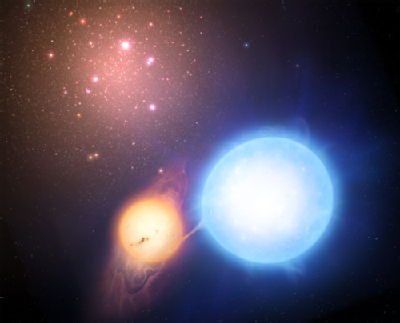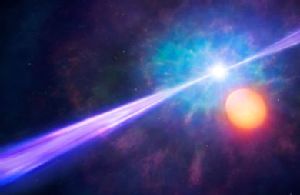Investigating Stellar Populations Across Cosmic Time.
PhD Project Outline for October 2023 start. Supervisor: Dr Elizabeth Stanway
When we observe a galaxy in the distant Universe, we see the integrated light from the galaxy - the total emission from all the stars, gas and dust, whatever their age and compositions. A large part of our understanding of galaxy evolution relies on decoding this information and determining where and when the stars which form that galaxy formed, how they may have influenced their environment or been influenced by it in turn, and how the individual stars that we can't see affect the galaxy that we can.

There are many approaches to this problem, but ultimately all of them rely to some extent on the comparison of the multiwavelength light from the galaxy with computer models which tell us what known stellar populations look like as they age and evolve. At their simplest these models can take a group of stars with known masses and add together their light. At their most complex, a stellar population synthesis model takes tens of thousands detailed computer models of stellar evolution and twins them with equivalent models which describe how the atmosphere of a star modulates their light.
Amongst such models are those generated by the Binary Population and Spectral Synthesis (BPASS) project. This specifically looks at the role of binary interactions between stars in modifying their light as a function of time and the impact this has on our interpretation of star forming galaxies at different redshifts (distances from Earth) and which form in different ways.

In the past we have used these to explore the way in which the light from globular clusters changes as their stars age (as shown in the image above), and the massive stars which explode as gamma ray bursts (the brightest explosions in the Universe, as shown in the image to the right). Both are heavily influenced by the possible impact of binary stars and the rate and which they occur in the Universe.
With the James Webb Space telescope about to launch, we're about to have unprecedented data on the nature and composition of galaxies in the distant Universe. All of that data requires models to interpret it, and will in turn influence the decisions and assumptions made in deciding the input physics of the next generation of models.
Starting in October 2023, I am seeking to recruit a funded PhD student to work with the BPASS team on shaping that next generation of models through a combination of working on the models themselves and working on the new data that will help to shape them. This could involve analysis of galaxies in the distant Universe, their local analogues or the host galaxies of astrophysical transients such as supernovae or gamma ray bursts and the effects that the composition and evolution of their progenitor stars have on our observations. It could also involve studying the specific types of stars which have the biggest impact on their surroundings and which may provide the photons that reionized our Universe at the end of the cosmic Dark Ages. Applications should be made through the Warwick Department of Physics PhD application procedure (i.e. not by email) as explained here, No research statement is required but please mention an interest in "Investigating Stellar Populations across Cosmic Time, supervisor: Stanway".
